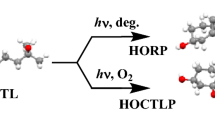Abstract
The nature of the products formed during the photoinactivation of Δ5-3-ketosteroid isomerase in the presence of the solid-phase photoaffinity reagent Δ6-testosterone succinyl agarose has been investigated after ultraviolet irradiation. The polypeptide products eluted from the agarose phase by sodium cholate, sodium dodecyl sulfate, and pH 10.5 triethylamine buffer have been characterized by sodium dodecyl sulfate polyacrylamide gel electrophoresis, pH 4–6 gel isoelectric focusing, and amino acid analysis. The amino acid compositions of the cholate eluted and SDS eluted products are found to be similar to that of native isomerase, whereas the covalently bound polypeptide eluted by pH 10.5 triethylamine possesses a distinetly different composition. Digestion of the covalently bonded isomerase polypeptide with trypsin yields an agarose-bound peptide fraction that has been characterized by its amino acid composition. This composition is different from that of the undigested covalently bound polypeptide and suggests that the site of covalent attachment lies somewhere between residues 28 and 45 of the isomerase polypeptide.
Similar content being viewed by others
References
Benisek, W. F. (1977).Meth. Enzymol. 46, 469–479.
Benson, A. M., Jarabak, R., and Talalay, P. (1971).J. Biol. Chem. 246, 7514–7525.
Benson, A. M., Suruda, A. J., Shaw, R., and Talalay, P. (1974).Biochem. Biophys. Acta 348, 317–320.
Hearne, M., and Benisek, W. F. (1983a).Biochemistry 22, 2537–2544.
Hearne, M., and Benisek, W. F. (1983b).Fed. Proc. 42, 2744.
Jarabak, R., Colvin, M., Moolgavkar, S. H., and Talalay, P. (1969).Meth. Enzymol. 15, 642–651.
Kawahara, F. S., Wang, S. F., and Talalay, P. (1962).J. Biol. Chem. 237, 1500–1506.
Kotite, N. J., and Musto, N. A. (1982).J. Biol. Chem. 257, 5118–5124.
Martyr, R. J., and Benisek, W. F. (1973).Biochemistry 12, 2172–2178.
Nakai, N., Lai, C. Y., and Horecker, B. L. (1974).Anal. Biochem. 58, 563–570.
Nordeen, S. K., Lan, N. C., Showers, M. O., and Baxter, J. D. (1981).J. Biol. Chem. 256, 10503–10508.
Ogez, J. R., Tivol, W. F., and Benisek, W. F. (1977).J. Biol. Chem. 253, 6151–6155.
Sadler, S. E., and Maller, J. L. (1982).J. Biol. Chem. 257, 355–361.
Schaltmann, K., and Pongs, O. (1982).Proc. Natl. Acad. Sci. USA 79, 6–10.
Smith, S. B., and Benisek, W. F. (1980).J. Biol. Chem. 255, 2690–2693.
Swank, R. T., and Munkres, K. D. (1971).Anal. Biochem. 39, 462–477.
Westphal, H. M., Fleischmann, G., and Beato, M. (1981).Eur. J. Biochem. 119, 101–106.
Wrigley, C. W. (1971).Meth. Enzymol. 22, 559–564.
Author information
Authors and Affiliations
Rights and permissions
About this article
Cite this article
Hearne, M., Benisek, W.F. Modifications of Δ5-3-ketosteroid isomerase induced by ultraviolet irradiation in the presence of the solid-phase photoaffinity reagent Δ6-testosterone agarose. J Protein Chem 3, 87–97 (1984). https://doi.org/10.1007/BF01024839
Received:
Published:
Issue Date:
DOI: https://doi.org/10.1007/BF01024839



